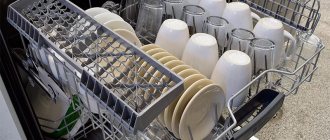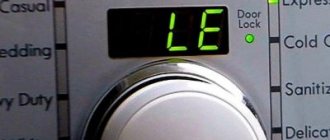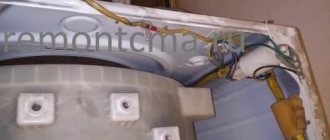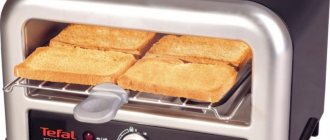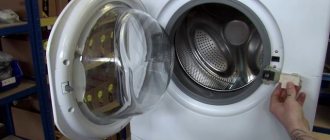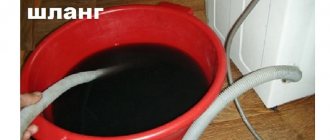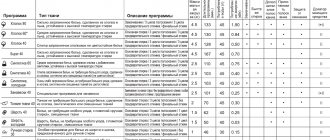Preparing the wash
Before you start working with a Samsung washing machine, you need to prepare the laundry itself. Typically, these recommendations are not specified in the instructions supplied with the mechanism, but they also affect the quality of cleaning and operation of the mechanism as a whole. General rules for preparing and sorting clothes are:
- Separate white, black and colored items from each other.
- Separate from each other things that are different in composition: cotton, synthetics, clothes with filling, wool - all these products are washed using different cleaning programs.
- Carefully study the labels on clothing and follow the instructions contained therein.
- Products containing clasps, snaps, buttons and other similar materials must be fastened first.
- It is recommended to pre-treat all stubborn stains with a stain remover, and only then load them into the drum.
- It is prohibited to put bras and clothes with small parts such as hooks, rhinestones, and beads into Samsung washing machines.
- If necessary, use water softeners, conditioners, rinses and flavoring agents.
First wash of laundry
If the idle start went well, then the next wash can be carried out together with the laundry.
Expert opinion
I work in the household appliance repair industry. Extensive experience in restoring washing machines and dishwashers.
Ask a Question
First, things need to be sorted depending on the recommended temperature. These recommendations on small tags on clothing must be followed very strictly. If you do not follow them, linen, especially knitwear, will lose its appearance, stretch, fade, discolor, and lose its shape.
- Further, if you do not have the skill to determine the weight by eye, it is better to weigh the mass of dry laundry intended for washing.
- The program is selected in accordance with the texture of the fabrics of the laundry placed in the hatch and the temperature conditions. The amount of powder required for the weight is poured into the compartment, and the conditioner is poured into the conditioner compartment.
- The program is selected, press the “start” button - the first wash has begun!
Are you using citric acid?
Oh yes! No
General recommendations for working with Samsung washing machines
Despite the fact that most operating rules for washing machines are usually indicated in the instructions supplied with them, there are several general recommendations for working with them:
- The Samsung washing machine should be installed on a flat floor to prevent the body from moving during the spin cycle.
- Load the drum completely. This way the mechanism will not wear out or break.
- At the same time, the drum should not be overloaded. Otherwise, the service life of the mechanism will be reduced significantly.
- If there is no need to use high temperatures, reduce the heating setting to 30 degrees. This will save energy.
- Set the spin level of the Samsung washing machine to 600 - 800 revolutions. When constantly operating at 800 rpm or higher, the oil seal and bearings deteriorate.
- According to the instructions, when selecting a program, the selector must be scrolled only clockwise.
- After each wash, wipe the sunroof glass dry. This will maintain the integrity of the elastic and prevent further liquid from entering under the cuff.
- It is worth wiping both the rubber band and the drum dry.
- Also, after washing, you need to ventilate your Samsung machine. To do this, open the container for loading the powder a few centimeters and leave it in this position for 20 minutes.
- After finishing work, unplug the Samsung washing device from the outlet. This will protect it from voltage surges.
- It is also worth cleaning out the detergent containers periodically. The body of the Samsung washing machine itself, according to the instructions, should be washed with a cleaning sponge, using soap and warm water.
- Once a month or two, give your Samsung machine a dry wash. To do this, pour the descaler into the dispenser, close the lid tightly, set the water heating temperature to high and press the “start” button. This will clean the main devices of scale and solid particles.
- Clean the filter once a month to remove small debris.
What should you pay attention to before storing and processing things?
After washing without laundry is started, you need to monitor how the washing machine works.
Particular attention is paid to the following points:
- are there any water leaks or extraneous sounds when the household appliance is operating;
- spinning and draining of water is carried out without any hitches;
- The drum of the machine rotates in accordance with the set cycle: when washing it slows down, when spinning it speeds up.
If the first run without laundry was successful, you can safely proceed to the washing stage with laundry.
Operating modes of a Samsung washing machine
Samsung washing machines include a variety of programs that allow you to choose the optimal conditions for cleaning a particular material from contamination. Their properties are described in more detail in the instructions for the washing device itself. Let's look at the existing operating modes in Samsung machines and determine their main differences from each other:
- Cotton. Designed for products made of dense natural fabric, therefore it has a long operating time and a high heating rate.
- Synthetics. The water temperature is low, the operating time is an order of magnitude shorter than the previous mode. Designed for fabrics that fade and deform easily.
- Children's. Involves high heat and several rinsing stages that effectively remove detergent residue.
- Wool. It is characterized by a low speed.
- Intense. Used for products with old stains or complex stains.
- Fast 29`. Accelerated washing process. Refreshes things, but does not fight complex stains. Characterized by high speed.
- Spin. An additional function that helps you get practically dry clothes.
- Economical washing. In this mode, virtually no heating occurs, and the liquid supply is minimal. This saves water and electricity.
- Prewash. The powder is poured into two compartments and the materials go through two cleaning stages at a time.
- Rinse + spin. Also used to freshen things up in 20 minutes.
- Jeans. Designed for denim clothing that is subject to fading and shedding.
- Delicate things. Used for thin and delicate products.
- Outerwear. Used for washing clothes with fillers, sports items and elastic materials.
Some models of Samsung washing machines have additional functions that are used to remove complex stains, for example:
- Active sports - fights sweat stains, grass and soil.
- Hygiene – copes with grease and blood stains.
- Kitchen – against stains caused by cooking or eating
- Active children are against paints, inks, felt-tip pens and other stubborn stains.
What should you do first?
Before first use, remove packaging. By the way, it is best to save it in case of subsequent return of the device during the warranty period. Sometimes for certain device models there is a requirement to provide them along with the packaging.
Then the shipping bolts are removed (they secure the tank to ensure trouble-free transportation) and, in general, everything that is on the bottom side, for example, foam plastic, cardboard.
Removing the transport bolts
After this, install the device itself on the surface as stably as possible, after which the water supply and drain are connected. If the transport screws are not removed first, they will cause strong vibration during operation of the equipment, which will lead to damage to the component parts of the device.
When first started, there should be no laundry in the machine being tested. If you put laundry there, then there is a risk that it will end up with an unpleasant odor at the end of the wash, because the new unit may contain various technical odors and lubricants, such as machine oil.
Although this does not always happen, it is better to be on the safe side in advance. It is enough to use a powder or a special product. They will just remove all technical contaminants from the inside.
Be sure to check the connection to the sewer and water supply before starting. When preparing the machine for the very first start, it is necessary to close the loading hatch, after which powder is added to the powder compartment. It is important that there are no foreign objects in the device.
The device is plugged into a power outlet. First you need to run a short washing program. After finishing washing, you should wait a little. For safety reasons, the machine will not allow you to open the loading door immediately.
After waiting a minute or two, open the door again. If the sink is suddenly clogged, the door will not unlock and the water from the drain will not be able to go down the drain, but will remain in place. So before the first wash, you need to thoroughly clean the drain and sink.
How to start washing in Samsung machines?
First, you should make sure that the liquid supply valve is open and the washing machine itself is plugged in. If everything is in order, load the necessary items into the drum and close the Samsung washing machine tightly. Add powder, conditioner and, if necessary, stain remover to the detergent container.
The next stage is choosing a mode. If you have any doubts when choosing the required program, read the marks on the product label again and look at the operating instructions for your Samsung washing device. Over time, the choice of modes will occur intuitively.
If a suitable program is not found, set the temperature, speed and other parameters manually using the rotary selector. Or choose additional washing machine features. After all the steps have been completed, turn on the “start” button.
Do not stop your Samsung machine when using a certain mode. Even if there is a power outage, the washing machine will automatically restore operation. If you still need to turn off the device urgently, press the special button, but under no circumstances remove it from the power supply.
Checking the washing machine for readiness to start
In order not to damage the parts of the washing machine and extend its service life, you need to carry out its first launch correctly, in accordance with all requirements.
Are you unplugging your washing machine?
Oh yes! No
To make sure that the unit is ready for operation, it is better to refer to the instructions and follow all the recommendations step by step. More details:
- The first thing you need to focus on is the absence of transportation bolts at the back of the machine. They are installed to transport the device and must be removed before the first start. Otherwise, they can damage many parts of the unit.
- Secondly, check the connection of the machine to the water supply and sewerage system. For amateurs, a rubber hose is mounted to a water pipe, and a corrugated hose is mounted to a sewer pipe, or to a siphon under the sink.
- The next step is to open the water supply tap to which the rubber inlet hose is connected.
- Then you need to inspect the device to make sure that all packaging materials - the adhesive tape holding the device parts - have been removed from the machine. Be sure to look into the drum so that there are no objects left in it either.
Now the unit is ready for the first start.
Washing machine Vestel F2WM 1040
Samsung washing machine error codes
Those models of Samsung washing machines that have displays display an error code on the screen in case of problems. The decoding of this code is in the instructions. For example:
- 1E, 1C, E7 – failure associated with the water level in the drum;
- EA, 3E, 2E1, 3E2, 3E3, 3E4, 3C, 3S1 – 3S4 – problems with the engine tachogenerator;
- E1, 4E, 4E1, 4E2, 4C, 4C2 – failures in water supply;
- E2, 5E, 5C – problems with draining the liquid;
- 8E, 8E1, 8C, 8C1 – problems with the vibration sensor;
- UC, E91, 9E2, 9C – electrical problems;
- AE, AC, AC6 – lack of communication in control modules;
- bE, bE1-bE3, BC2, EB – failure of the buttons on the control panel;
- CE, AC, AC6 – hot water is drained;
- dE, dE1, dE2, DC, DC1, DC2, ED – the hatch door is faulty;
- FC, FE – problems with the ventilation system;
- NOT, HE1–HE3, NS, H1, H2, NS1, NS2, E5, E6 – problems with the heating element;
- E9, LE, LE1, LC – liquid leaks;
- 0C, 0E, E3, 0F – too much water in the drum;
- TS, TS1-TS4, EC, tE1-tE3 – temperature sensor malfunctions;
- EE – the device has overheated;
- SD, 5D, SUdS, Sud – excessive foam formation.
Final recommendations for using Samsung washing machines
Samsung is characterized by a wide range of washing machine models. All of them are easy to use, versatile and have a wide price range. In addition to the main modes: cotton, synthetics, express wash, children's clothes, there are additional ones that carefully clean delicate fabrics and effectively combat stains based on the cause of their occurrence.
Using the codes that appear on the display, you can quickly find out about existing problems during operation of the device. Just look at the instructions for your Samsung washing machine.
The most common causes of breakdowns of Samsung washing machines are non-compliance with the rules of their operation, incorrect connection of the mechanism or frequent failures in the electrical network. Therefore, try to follow all the advice specified in the instructions, check that all parts of the mechanism are correctly secured to the electrical and water systems of the room. If your house has problems with voltage surges, install a separate circuit breaker to protect the mechanism from possible negative consequences.
